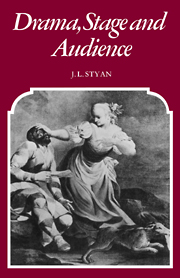Summary
Probably the most elusive and most neglected, but also the most essential, element of a play is its style. Style is the sine qua non of successful communication in the theatre, and therefore of tie drama's affective meaning. Comic style is especially the source of numerous literary misunderstandings, but any style can be deceptive and treacherous. What if an audience feels for Orsino and laughs at Viola? laughs at Gloucester and feels for Edmund? – any of these is possible, and each response is determined absolutely by the manner of performance.
Who might not think from Olivia's generous reference to Malvolio's treatment in Twelfth Night, ‘He hath been most notoriously abused’, that this is not Shakespeare's cue for the playing of the Steward's part? But no actor has ever managed to play him for tragedy, not even Irving. Even when Charles Lamb wished upon him tragic overtones in his account of Robert Bensley's performance in his essay ‘On Some of the Old Actors’ – ‘I confess that I never saw the catastrophe of this character, while Bensley played it, without a kind of tragic interest’ – Elia was following his fancy and not the performance, as Sylvan Barnet has proved. The truth is that nothing in the style of Malvolio's turkeycock playing or its context permits this response, unless it is one engendered deviously outside the theatre. The image on the stage of what is properly a caricature of Puritanism acting the great lover should be enough to forestall any extra-theatrical judgment. Whoever had feelings about a caricature?
- Type
- Chapter
- Information
- Drama Stage and Audience , pp. 68 - 107Publisher: Cambridge University PressPrint publication year: 1975



